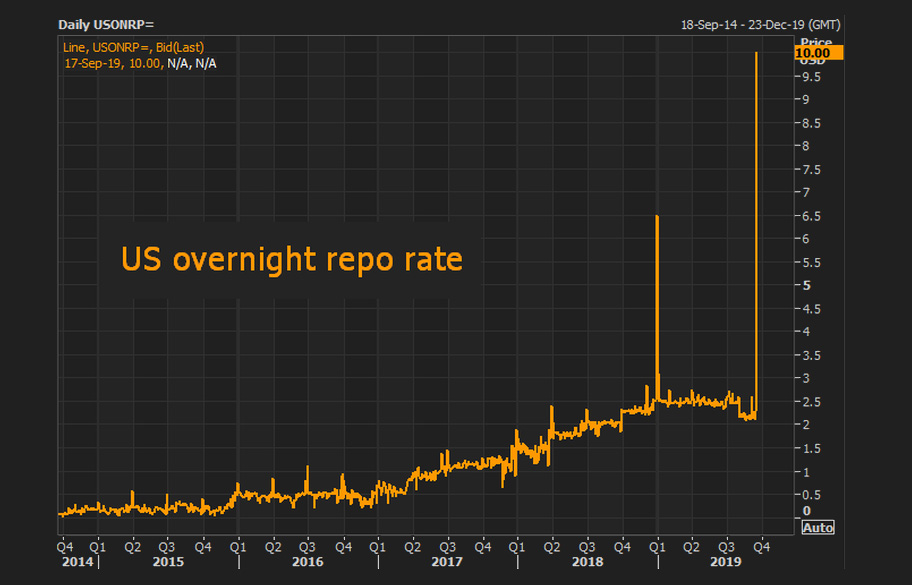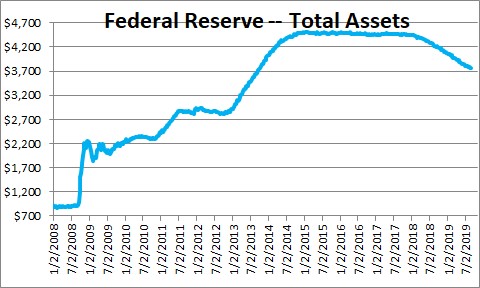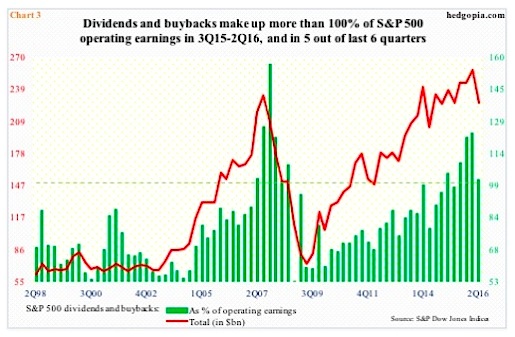So basically every night, after trading closes, people put in bids that make it look like things are going to crash at open tomorrow. So the Fed says, "Hey, don't worry. For half an hour we are going to artificially inflate the prices to their previous state so nobody loses money." So the sellers begin trading at market open, knowing they are protected from the price dropping below a certain point, and go on their merry way trading just like nothing is wrong. But something is VERY wrong; those aren't market prices. Those are gerrymandered prices that do not reflect the actual value of the items being traded. It's just insider trading, but everyone is an insider, and knows it can't go on, but they can't NOT do it, or they'd lose money (and their jobs). So their ACTUAL confidence is weakened every single day, while their reportable performance in the market makes them seem confident in a robust economy... and everyone knows the king is naked, but they cheer and follow him down the path anyway... And then something happens that people didn't predict... and everything collapses, but nobody has models for what to do in THIS collapse, because the potential outcomes were unpredictable... but the fact that it WOULD happen is expected. What a clusterfuck.
Take it back a step: this is the WSJ video on Repo markets I linked in the post "why did the Karens suddenly stop lending." Because it still amuses the fuck out of me that the WSJ is referring to "marks" (institutions who buy) and "Karens" (banks that stop lending). There's a lot of jargon in finance. I have beef with this. So basically: In order to buy and sell stuff while also owning stuff, there needs to be a market where stuff collateralizes money. There's an organization whose job it is to control how much profit that market makes and starting in September, that market started telling the organization to eat shit. The organization responded by filling it full of money so that now, it is controlling how much profit that market makes by pouring money into it. In short, a closed system is now open. This "closed system is now open" is the basic shape of every financial crisis you've ever seen, but don't tell the rubes that.
You think you understand what the repo market does, but you do not. The Fed does not control the overnight lending rate - it "targets" it. The fed started injecting billions into the repo market because its "targeting" was failing miserably: The whole of the financial press worried this one around in their mouths for a month or so; it couldn't be as simple as the market setting a price other than the Fed's target, could it? Yet what was happening was that nobody wanted to lend overnight at 2%. They wanted to lend overnight at 5%. So in order to "target" the 2% rate, the Fed had to lend to everyone who needed it at 2% and undercut everyone who was lending at 2.01%. So here's the question: is that artificial rate suppression? Because when we did it in 2008, it was recognized as artificial. And it was recognized as what was necessary to keep the economy from going Tango Uniform. And it launched Occupy Wall Street, and it launched Bitcoin, because the rank and file non-hedge-fund class had been led to believe that if you screw up in the market you lose all your money. You're right - the Fed did raise interest rates. However, they didn't exactly unwind their balance sheet. They started, sure - a lot of people observed how fucking dumb it was to raise rates and close out positions at the same time but here we are. Oops! That's from before we all had to learn what Repos are. Here's the important thing, considering you started out dickering with the graph and then expanded. That's a daily price graph - or, more likely, a 2-hr or the like. Thing is, it's actual trading. Repos exist primarily to calm the futures market - the guys who are playing the game before the game opens for the day. Announce $26b in repo cash at midnight which closes at 8:30am and what you're doing is keeping the futures market from dipping to minus 200 which makes the bots happy which means everyone is in a buying mood and w00t w00t the stock market isn't about to crash after all. Here's what you're missing: the origin point of those arrows comes from a sharp overnight downturn, every time. And every time, it prompts a stark rise in the S&P. Which is what the financial press will report on - it's always a form of "the S&P erased earlier lows to end at another record high." I get two or three of those a day from Yahoo, the WSJ, The NYT. Repo market stuff? You gotta hunt it up. Here's the bottom line: we're both agreed that the Fed probably doesn't want to do this. If you look at that balance sheet you can see exactly what they wanted to do. Then Powell handed his nuts to Trump and now they're doing whatever keeps the stock market inflated. And that is pretty much "give money to rich people" which is 2008 all over again. And that is the reason everyone's beefing. Tesla has a market cap greater than Ford or Chevy combined. Tesla has never had a dividend. Ford is usually good for fifteen cents a share; Chevy for thirty eight or so. A share of Tesla? $538 as of this writing. Ford? $9.23. GM? $35.05. That's 0.6 cents per dollar for Ford and 0.9 cents per dollar for GM in dividends alone; If you pile your money into GM you'll make $60 a year for every share of Tesla you felt like buying. That's what Graham would tell you to do. But then, Graham would wash his hands of this market. Which is the argument ole Sven is making. Johan de Nysschen, back before he left Audi to join Cadillac to leave Cadillac to rejoin Volkswagen, said something like "Tesla makes nice cars. We would like to make cars like Tesla but our shareholders require us to be profitable". Tesla was at $305 then. They're at $530 now. If you owned Tesla and held it you've made $230. If you owned $300 worth of GM you've actually "lost money" in that the stock is flat, despite the fact that it's provided you with about $200 worth of dividends, which you could have reinvested or bought Ford with or whatever. This market punishes you for holding GM and rewards you for holding Tesla because its value will be "much bigger in the future." Like airlines. -- Warren Buffett, in the 2007 Berkshire Hathaway shareholder letter Yes. It's been twelve years since the great recession. Please refer to the fed balance sheet graph above. Here's the basic beef: the people who aren't banks are allowed to lose money while the rest of us get to twist in the wind. That privilege is about to be extended to hedge funds. This has made the investing class angry. Again.


The worst sort of business is one that grows rapidly, requires significant capital to engender the growth, and then earns little or no money. Think airlines. Here a durable competitive advantage has proven elusive ever since the days of the Wright Brothers. Indeed, if a farsighted capitalist had been present at Kitty Hawk, he would have done his successors a huge favor by shooting Orville down.
Lending cash. To hedgefunds. During one of the biggest bull runs ("bull" requiring quotes, since maybe 2018 w/ Trump's tax cuts) that the market has ever had. Yeah, that makes sense. Let's sell all federal student loan debt to private companies, and then take that money and lend it to hedgefunds too after we run out of our first batch of money.
Let's be clear: the bull run is due to loaned cash. A lot of the intelligentsia are already calling this repo kerfuffle QE4; opening the Fed to hedge funds is kind of like injecting coke when your septum is too deviated to allow you to snort it any longer.Lending cash. To hedgefunds. During one of the biggest bull runs that the market has ever had.

I think my question isn’t really how this will end so much as how badly this will end?
So here's the great dichotomy of our economy: ostensibly we're a regulated capitalist society whereby the market is permitted to work its efficiencies through the invisible hand. However, the more sophisticated your market the greater the influence of its regulation. If you care about the market, you let bad things happen to it in order to restore equilibrium. If you care about the society, you protect it from the bad things in order to prevent deutschmark bonfires and the like. Economics in a nutshell. The downside is that there are no relationships that prevent regulation from killing the market or the market from destroying society and because it's damn hard to run lab tests on the global economy, we're all lab rats. A few places this goes: 1) Steady capital injections of whatever the market needs returns it to its previous equilibrium. I mean, it could happen. Anything could happen. 3-2-1 Contact told me 40 years ago that overpopulation and peak oil were going to kill me just in time for the new Ice Age. 2) Steady capital injections of whatever the market needs makes the market insatiably hungry for capital. This is kind of what we're seeing. Will we be able to feed it forever? I've seen it suggested that eventually the Fed will just start buying stocks. Stranger things have happened. We're here talking about the Fed directly loaning money to hedge funds. The Swiss Central Bank owns enough apple stock for every citizen of Switzerland to have a $350 share. I believe we call that a corporatocracy. 3) Eventually the Fed can't feed the beast enough and the beast recoils. Everyone dumps their position so as to not be left holding the bag. Do the robots buy it back up? Who knows. What does a crash look like when the crashers are robots and the money is external? Bitcoin exists because enough cypherpunks were pissed off about the first bailout. It's been ten years. The song remains the same. The bailouts happened because Ben Bernanke was one of the foremost scholars of the Great Depression and he thought he had a pretty good idea how to keep it from happening again. He was right - he prevented a second great depression. But he didn't stave off disaster entirely. One of the reasons I pay attention to John Mauldin is he called 2019 in 2009. I wonder how this will end every single day.
You know, that’s a really interesting point of wtf do the algorithms end up doing in the event of abrupt market or regulatory changes? Do they function in a manner that eases the financial impact or do we find out that the software behind all this isn’t suited for bear markets or lack of bailouts? Maybe that’s too Y2K esque.
your circledot breakdown: 4% for the graph and information, 96% for the analogy
